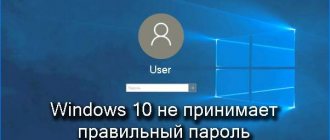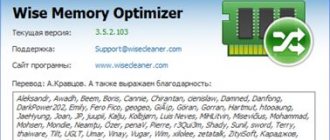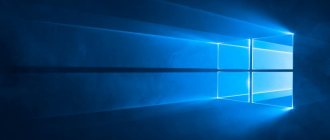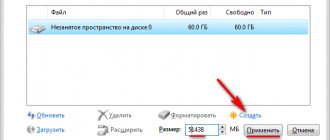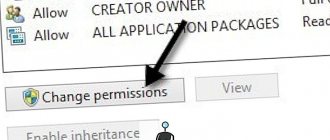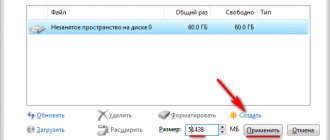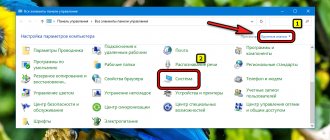Unloading the processor
Many factors can influence the processor overload, which leads to slow operation of your PC. To offload the CPU, it is necessary to analyze various problems and make changes in all problematic aspects.
Method 1: Cleaning startup
The moment you turn on your PC, all software products that are located in the startup cluster are automatically downloaded and connected. These elements practically do not harm your activities on the computer, but they “eat up” a certain CPU resource while in the background. To get rid of unnecessary objects in startup, follow these steps.
- Open the Start menu and go to Control Panel.
Go to the “Administration” section.
Open the “System Configuration” sub-item.
We do not recommend turning off anti-virus software from this list, since it may not turn on after a further reboot.
Click on the “OK” button and restart the computer.
You can also see the list of components that are automatically loaded in the database sections:
How to open the registry in a way that is comfortable for you is described in the lesson below.
Method 2: Disable unnecessary services
Unnecessary services run processes that create unnecessary load on the CPU (central processing unit). By disabling them, you will partially reduce the load on the CPU. Before turning off services, be sure to create a restore point.
When you have created a restore point, go to the “Services” subsection, which is located at:
Control PanelAll Control Panel ItemsAdministrationServices
In the list that opens, click on the unnecessary service and right-click on it, click on the “Stop” item.
Right-click on the required service again and go to “Properties”. In the “Startup Type” section, select the “Disabled” sub-item and click “OK”.
Here is a list of services that are usually not used when using a PC at home:
- "Windows CardSpace";
- "Windows Search";
- "Offline files";
- "Network Access Protection Agent";
- "Adaptive brightness control";
- "Windows Backup";
- "IP Auxiliary Service";
- “Secondary login”;
- “Grouping of network participants”;
- "Disk Defragmenter";
- “Automatic remote access connection manager”;
- “Print Manager” (if there are no printers);
- "Network Member Identity Manager";
- "Performance Logs and Alerts";
- Windows Defender;
- "Secure storage";
- “Configuring a remote desktop server”;
- “Smart Card Removal Policy”;
- "Homegroup Listener";
- "Homegroup Listener";
- “Network login”;
- "Tablet PC Input Service";
- “Windows Image Upload Service (WIA)” (if you don’t have a scanner or camera);
- "Windows Media Center Scheduler Service";
- "Smart card";
- “Diagnostic system unit”;
- "Diagnostic Service Node";
- "Fax machine";
- "Performance counter library host";
- "Security Center";
- "Windows Update".
Method 3: Processes in Task Manager
Certain processes load the OS very heavily; in order to reduce the CPU load, you need to turn off the most resource-intensive ones (for example, running Photoshop).
- Go to the “Task Manager”.
Go to the “Processes” tab
Click on the subheading of the “CPU” column to sort processes depending on their processor load.
The CPU column shows the percentage of CPU resources that a particular software solution is using. The CPU load level of a specific program varies and depends on the user’s actions. For example, an application for creating 3D object models will consume much more CPU resources when processing animations than in the background. Turn off applications that use up your CPU excessively even in the background. Next, we identify processes that are consuming too much CPU resources and disable them.
If you are not aware of what a certain process is responsible for, then do not terminate it. This action will cause a very serious system problem. Use an internet search to find a complete description of a specific process.
Click on the process of interest and click on the “End process” button.
We confirm the completion of the process (make sure that you know the element to be disabled) by clicking on “End process”.
Method 4: Cleaning the Registry
After completing the above steps, there may be incorrect or empty keys left in the system database. Processing these keys can be CPU intensive and must be uninstalled. The CCleaner software solution, which is freely available, is ideal for performing this task.
There are several other programs with similar capabilities. Below you will find links to articles that you need to read to safely clean the registry of all kinds of junk files.
Method 5: Antivirus scan
There are situations when processor overload occurs due to the activity of virus programs in your system. In order to get rid of CPU overload, you need to scan Windows 7 with an antivirus. List of excellent antivirus programs in the public domain: AVG Antivirus Free, Avast-free-antivirus, Avira, McAfee, Kaspersky-free.
Using these recommendations, you can relieve the processor in Windows 7. It is extremely important to remember that you need to perform actions with services and processes that you are confident in. Otherwise, it is possible to cause serious harm to your system.
Thank the author and share the article on social networks.
A loaded computer's central processor is the main reason for its slowdowns and freezes. Moreover, in order to identify what exactly is the source of trouble, sometimes you have to approach the issue outside the box. This article will describe both simple ways to solve the problem and those that require some technical training.
First steps to solve the problem with the Svchost.exe process
If you have a situation where the host process Svchost.exe is heavily loading the processor, then you should not immediately think that it is a virus. In addition to the virus, the OS itself may be the culprit of this problem. Below we will look at a list of problems, as well as methods for fixing them:
After opening this directory, it must be completely cleared. The next step is to repeat the steps described in the second method. Removing files from this directory helps remove OS settings that are specifically designed to speed up Windows. But there are times when these settings cause the Svchost.exe host to load the CPU up to 100 percent.
How to Reduce Windows 7 CPU Load: Identifying Heavy Processes
To find out the specific processor load level, use the tool built into the operating system - the task manager. To open it, just press the key combination Ctl+Shift+Esc. Click on the “Display processes of all users” button. Select "YES" in the pop-up window. The task manager is now running with administrator rights.
Go to the "Processes" tab, there you can see all the applications currently running. By clicking on one of the table column names, you can sort them.
Diagnostics
High CPU usage in itself is not a problem. All resources can be consumed when launching games, ultra-high quality videos, video editing applications, archivers, and antivirus checks. First of all, you need to check whether the processor is really overloaded or whether other problems are causing the slow operation.
Press Ctrl+Shift+Esc to open Task Manager and click on the CPU column to sort. You can also get to the dispatcher by pressing Ctrl+Alt+Del and selecting the desired item in the menu that appears.
In the “Permissions” tab we can configure the level of access of another user to files
Normally, a task list should look something like this. When the load is high, one or more tasks will consume most of the CPU time. If one of the applications takes 50-100% of its power constantly, this may be a symptom of a problem.
For example, in the screenshot, almost half the power of the i5-2500k processor is occupied by the “Task Manager” and system interrupts, which should not be the case.
High CPU usage Windows 7: what to do?
Having found a suspicious process in the task manager that takes up the lion's share of system capacity, right-click on its name. In the context menu that opens, select “complete”, then answer the question in the task manager in the affirmative.
It must be said that applications sometimes freeze when closed using standard means. The program window disappears, but the process does not end, and on top of that, it goes into an endless loop. You can successfully deal with such a nuisance if you restart your computer, but the task manager will allow you to solve the problem faster.
Method 8: Run a Windows Defender Scan
Windows Defender will scan all files on the system and check for malware. If threats are detected, you can remove them from your computer. Here are the steps to scan your PC:
1. Type Virus & Threat Protection in Windows Search . Launch it.
2. Click Scan Options .
3. Select Full Scan and click Scan .
Note. Make sure the laptop is charged and nothing is interfering with the scanning process.
A full scan checks all files and running programs on your hard drive. This scan may take more than an hour.
Process Explorer
If you have followed all the above recommendations, but the CPU load has not decreased, and there are no processes that use a lot of resources, try using a free utility called Process Explorer. You can download it from the manufacturer's official website.
How to reduce CPU load on Windows 7 using Process Explorer? In the program window, sort the list of processes by CPU load. Examine the table for suspicious applications. If there are any, right-click on the program name and select Kill Process.
How to identify the System Inactivity virus
The above discussed the standard operation of the System Idle service in Windows, but this process can also be infected with malicious code. It is convenient for viruses to disguise themselves as “System inactivity,” especially for “miners,” since the user may not be suspicious that a large percentage of CPU consumption is indicated next to this process.
Experts recommend the following way to determine that the “System Idle” process is viral:
It is worth noting that most often viruses, when disguised as “System inactivity,” keep the CPU value for this process at 99, and it does not change even when the computer is loaded with heavy applications.
Drivers
System drivers are one of the most common causes of system interrupts loading the processor. To see if it's worth updating your drivers, do the following:
- Restart your computer.
- Before turning on the OS, press the F8 button on your keyboard several times.
- In the menu that opens, select “Safe Mode”.
- After loading the operating system, launch the Process Explorer application and watch the interrupts line for a while.
If system interrupts do not boot your computer, there is a high probability that the problem is with the drivers. In this case, you should go to the official websites of your PC hardware manufacturers. If updates appear, install them. If any device uses universal Microsoft drivers in its operation, it is necessary to replace them with proprietary ones.
It must be said that the measures taken will not necessarily solve the problem, and only a complete reinstallation of the operating system can help the computer.
Overheat
High CPU temperatures can also contribute to high CPU utilization. The computer constantly crashes, freezes, slows down and reboots on its own. If the cooler noise increases, it is worth checking whether the processor is overheating. When working on a laptop, you can simply move your hand on the side where the air is blown. If it is hot, it is best to monitor the temperature with special means.
Periphery equipment
How to reduce CPU load in Windows 7 if previous recommendations did not help? Disconnect all devices without which the computer can operate. Leave the minimum - keyboard, mouse, monitor. Look at the task manager graphs. A decrease in processor load means that one of the peripheral devices is failing.
To figure out which one, connect them one at a time. After adding a new one, restart your computer and watch the graphs. If after connecting the next device the CPU load increases, you need to update the drivers for this device. When a software update does not help, there is only one way out - replacing the equipment or repairing it. It is not recommended to delay these procedures. As the load increases, the temperature of the CPU also increases, and this can reduce its service life.
Method 4: Turn off Windows notifications
When Windows notifications are enabled, it can cause significant CPU usage. This means that turning them off can help relieve some of the stress. Here's how to reduce high CPU usage:
1. Type Notifications in the Windows search box . Click Notifications & Actions Options in the search results.
2. Turn off
the switch for the Receive notifications from apps and other senders .
Check if CPU usage has dropped by following the steps in How to check CPU usage in Windows 10 .
Computer games
Modern games are a real challenge for PCs. Only engineering programs used to perform complex mathematical calculations can compare with them. If the CPU is running at 100% in games, it clearly needs an upgrade.
How to reduce the load on the Windows 7 CPU if an upgrade is not possible? Try closing all unnecessary applications before starting the game. Disconnect your computer from the network to prevent it from unexpectedly downloading updates for its software. Close antivirus programs, because this type of software consumes a lot of computer resources. The antivirus monitors absolutely all PC activity, which negatively affects its performance.
Be careful: if you do not understand well the consequences of disabling software security features, it is not recommended to follow the last tip.
One of the most common reasons why a computer slows down is because the processor is loaded, sometimes by incomprehensible applications and processes.
Not long ago, on a friend’s computer, I had to deal with an “incomprehensible” CPU load, which sometimes reached 100%, although there were no open programs that could load it like that (by the way, the processor was a fairly modern Intel inside Core i3). The problem was solved by reinstalling the system and installing new drivers (but more on that later...).
Actually, I decided that this problem was quite popular and would be of interest to a wide range of users. In the article I will give recommendations that will help you figure out why the processor is loaded and how to reduce the load on it. So…
1. Question No. 1 - what program is the processor loaded with?
To find out what percentage of the processor is loaded, open the Windows task manager.
Buttons: Ctrl+Shift+Esc (or Ctrl+Alt+Del).
Next, in the processes tab, all applications that are currently running should be displayed. You can sort everything by name or by the load created on the CPU and after that remove the desired task.
By the way, very often the problem arises in the following way: you were working, for example, in Adobe Photoshop, then closed the program, but it remained in the processes (or this happens all the time with some games). As a result, they “eat” resources, and not small ones. Because of this, the computer starts to slow down. Therefore, very often the first recommendation in such cases is to restart the PC (since in this case such applications will be closed), or go to the task manager and remove such a process.
Important! Pay special attention to suspicious processes: those that heavily load the processor (more than 20%, and you have never seen such a process before).
Application accepted
A fairly common problem with slow loading of videos and pages is the load on your computer's central processor. This problem occurs in the following cases: - There may be a virus on the computer that is deliberately loading the processor - There may be an application running that loads the computer - and the last reason is simply an outdated computer that cannot work with sufficient speed to ensure smooth operation. How can you check what the reason is?
It’s quite simple to check; first you need to close all open applications and press the hotkey combination Ctrl+Alt+Del (if you have Windows 7 or 8, then after pressing these keys you need to select Task Manager). You should see a window like this:
There are bookmarks in this window, we only need a few: Applications - this tab displays all running applications (programs) Processes - this is a very necessary tab that contains the entire list of running applications and services, here we need to make sure that no application loads the processor , if your processor load is equal to or close to zero as in the image below, then everything is fine:
If there is an application that constantly loads the processor by more than 50%, then this may be evidence of a virus or a weak processor.
Performance - This section will help us determine how much the processor is loaded when using the Internet and watching videos:
This tab contains the following sections: CPU load - the most important information is displayed here, thanks to which we can identify the problem, this will be written about later. Memory is also an important indicator that shows how loaded the RAM is.
Question No. 2 - there is CPU load, but there are no applications and processes that load them! What to do?
When setting up one of the computers, I encountered an incomprehensible CPU load - there is a load, but there are no processes! The screenshot below shows what it looks like in the task manager.
On the one hand, it’s surprising: the “Display processes of all users” checkbox is turned on, there is nothing among the processes, and the PC load jumps by 16-30%!
To see all the processes that load your PC, run the free Process Explorer utility. Next, sort all processes by load (CPU column) and see if there are any suspicious “elements” there (the task manager does not show some processes, unlike Process Explorer).
Process Explorer - loads the processor on
20% system interrupts (Hardware interrupts and DPCs). When everything is in order, usually the CPU load associated with Hardware interrupts and DPCs does not exceed 0.5-1%.
In my case, the culprit turned out to be system interrupts and DPCs. By the way, I will say that sometimes fixing the PC load associated with them is quite a troublesome and complicated task (besides, sometimes they can load the processor not only by 30%, but by 100%!).
The fact is that the CPU is loaded due to them in several cases: problems with drivers; viruses; the hard drive does not operate in DMA mode, but in PIO mode; problems with peripheral equipment (for example, printer, scanner, network cards, flash and HDD drives, etc.).
1. Problems with drivers
The most common reason for CPU usage is system interrupts. I recommend doing the following: boot the PC in safe mode and see if there is a load on the processor: if there is none, the reason is very high in the drivers! In general, the easiest and fastest way in this case is to reinstall the Windows system and then install one driver at a time and see if the CPU load appears (as soon as it appears, you have found the culprit).
Most often, the culprit here is network cards + universal drivers from Microsoft, which are installed immediately when installing Windows (sorry for the tautology). I recommend downloading and updating all drivers from the official website of your laptop/computer manufacturer.
I think it’s not worth spreading too much about, which could be due to viruses: deleting files and folders from the disk, theft of personal information, CPU load, various advertising banners on top of the desktop, etc.
Plus, sometimes check your computer with third-party programs (which look for advertising modules adware, mailware, etc.):
3. Hard disk operating mode
The operating mode of the HDD can also affect the loading and performance of the PC. In general, if the hard drive is not operating in DMA mode, but in PIO mode, you will immediately notice it with terrible “brakes”!
4. Problems with peripheral equipment
Disconnect everything from your laptop or PC, leave the bare minimum (mouse, keyboard, monitor). I also recommend paying attention to the device manager to see if there are any installed devices with yellow or red icons (this means either there are no drivers or they are not working correctly).
How to open device manager? The easiest way is to open the Windows Control Panel and type the word “manager” into the search bar. See screenshot below.
Actually, all that remains is to view the information that the device manager will provide...
Device Manager: there are no drivers for devices (disk drives), they may not work correctly (and most likely not work at all).
Method 9: Change Power Plan Settings to Defaults
If the PC's power supply is set to power saving mode , the computer will heavily load the processor. Here 's how to reduce high CPU usage by returning settings to default
1. Type Control Panel and launch it from the Windows search .
2. Click View > Small Icons . Then go to Power Options .
3. Select Balanced if the computer is in power saving .
4. Now click on Set up power plan .
5. Here, click Restore the schema to default settings .
6. Finally, click Yes to confirm and apply these changes.



